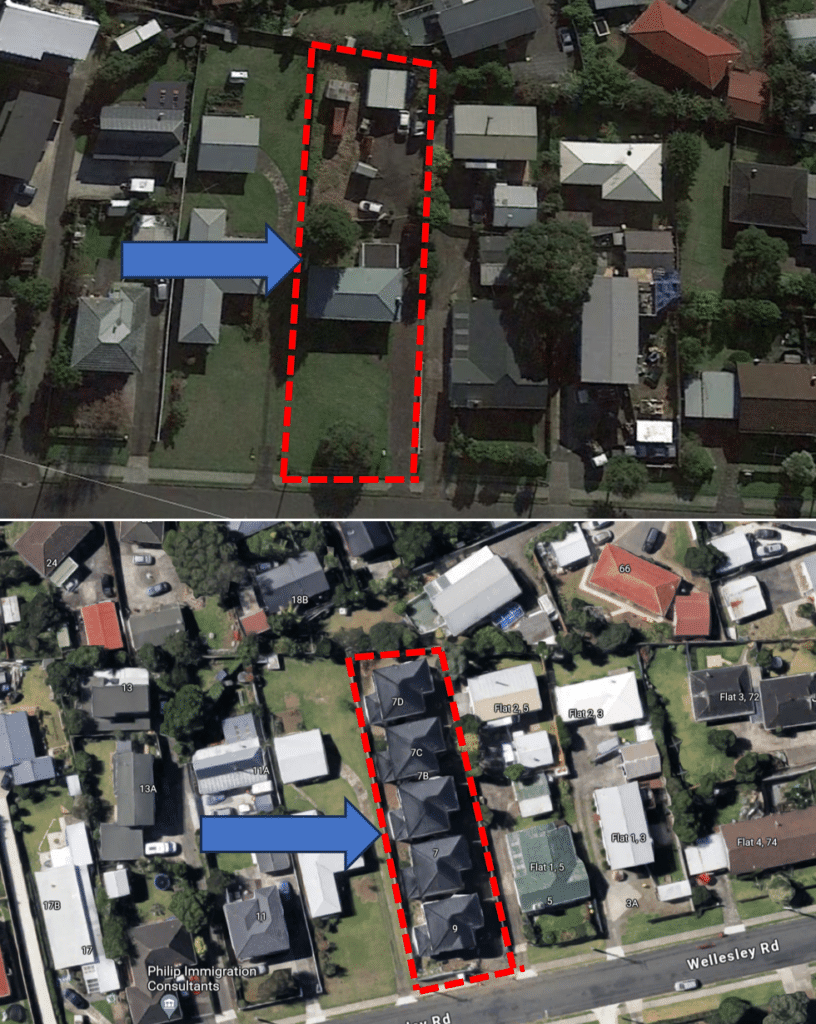Despite changes in zoning bylaws, the construction of missing middle housing (ADUs) in North American cities has been limited. This blog post summarizes the excellent report by abouthere.ca that explores the reasons behind this and suggests potential solutions to address the housing crisis. We also discuss the implications for Ontario housing supply and Accessory Dwelling Unit buildout. Take some time to view the video by About Here, titled “Why your City is STILL Struggling to Build ‘Missing Middle’ Housing.” Without exaggeration, this video summarizes the issue more clearly than almost anything you will find on the internet.
Challenges in Implementing Zoning Changes
Cities like California, Minneapolis, and Vancouver have attempted zoning changes to allow for increased housing density in single-family neighbourhoods. However, these well-intentioned efforts often clash with community resistance, stringent regulations, and an arduous approval process.
California’s Housing Shortage
California’s severe housing shortage led to a push for zoning changes. However, despite legislative efforts, community resistance and complex regulatory environments have limited the effectiveness of these changes. The high cost of land in desirable neighbourhoods further complicates the scenario, making it financially unfeasible for many developers.
Minneapolis 2040: An Ambitious but Challenging Plan
Minneapolis’s Minneapolis 2040 Plan aimed to address housing affordability and racial disparities. However, residents raised concerns about increased traffic and changes in neighbourhood character. These factors, combined with regulatory challenges, have dampened the plan’s impact on housing construction.
Vancouver’s Affordability Crisis
Vancouver faces its own set of challenges, similar to those in California and Minneapolis. Despite efforts to increase housing density, the city struggles with community resistance and regulatory hurdles, which have stymied anticipated housing construction.
The challenges in implementing zoning changes to allow for more housing in single-family neighbourhoods are evident. Despite the intention to address housing shortages, the construction of new housing units has fallen short of expectations. To effectively tackle the housing crisis, it is essential to address the challenges faced in implementing zoning changes. This may involve streamlining approval processes, engaging with communities to address concerns, and developing strategies to overcome resistance. Only through comprehensive and thoughtful approaches can zoning changes truly lead to significant construction and increased housing supply.
Barriers to Building Missing Middle Housing
Developing missing middle housing can often be a complex and challenging process. There are several key barriers that developers face when trying to bring these types of housing options to single-family neighbourhoods. Understanding and addressing these barriers is essential to creating more diverse and affordable housing choices for residents.
High cost of land in single-family neighbourhoods hinders development
These single-family neighbourhoods are often highly desirable, with limited available land for development. As a result, the cost of purchasing land in these areas can be significantly higher compared to other parts of the city or region. This high cost of land creates financial challenges for developers, as they must factor in the cost of acquiring the land when determining the feasibility of a missing middle housing project. In many cases, the land cost alone can make it difficult for developers to achieve a reasonable return on investment.
Additional parking requirements and development charges pose real challenges
Parking requirements can also pose challenges, as they often necessitate the construction of on-site parking spaces. However, these requirements may not align with the transportation patterns and preferences of residents in missing middle housing, who may be more inclined to use alternative modes of transportation such as walking, biking, or public transit. Also, while parking is important, it cannot be the reason to disallow projects. The housing crisis has just begun.
Addressing these barriers requires a multi-faceted approach. This may include exploring strategies to reduce the cost of land, streamlining regulations to minimize additional requirements and costs, and working with lenders to provide financing options tailored to the unique challenges of missing middle housing projects. By addressing these barriers, we can create an environment that encourages the development of missing middle housing, providing residents with more diverse and affordable housing options in single-family neighbourhoods.
Successful Approach in New Zealand
When it comes to addressing the housing crisis, it is essential to explore successful approaches and potential solutions that have been implemented around the world. One such example is Auckland, New Zealand, where a unique approach of allowing more density and reducing parking minimums has resulted in significant new dwellings being created.
Auckland’s Approach: Up-Zoning
Auckland recognized the need for increased housing supply to keep up with the growing population. By allowing more density, such as allowing the construction of apartments and townhouses, they were able to create additional housing options for residents.
This approach has proven to be successful, as it has led to the creation of a significant number of new dwellings in Auckland. By maximizing land use and building housing options that cater to different needs, the city has been able to address the housing shortage to some extent.
Tradeoffs and Acceptance
While the solution adopted by Auckland has proven effective, it is important to acknowledge that addressing the housing crisis often requires trade-offs. This includes making changes to existing requirements and being open to physical changes in neighbourhoods.
Trade-offs may involve relaxing specific zoning regulations or allowing more flexibility in development plans. Some residents are concerned about the character of their neighbourhoods. However, it is essential to strike a balance between preserving the community’s identity and addressing the urgent need for housing.

In this example, a single-family dwelling has been converted into five separate two-story homes.


Acceptance of physical changes to neighbourhoods is crucial for successfully implementing solutions to the housing crisis. This can involve accepting taller buildings, mixed-use developments, and a diverse range of housing options. By embracing these changes, communities can contribute to easing the housing shortage and creating more inclusive and vibrant neighbourhoods.


New Zealand Zoning Reform
The graph provided, created by Grennaway-McGrevy and Jones in 2023, depicts council approvals for new home construction. It presents two distinct lines: the blue line representing the up-zoned areas and the dark blue line representing the unaffected zone. Over a span of six years, the graph shows a significant and noteworthy development – a four-fold increase in applications for new home construction. This data showcases a tangible and remarkable change that has taken place, offering inspiration for potential implementation within the province of Ontario as well.
Considering the graph’s implications, policymakers and urban planners in Ontario may find it valuable to explore similar strategies. By identifying areas where up-zoning could be implemented strategically, they could encourage an increase in housing development, fulfilling the needs of a growing population. Infrastructure capacity is the go-to criticism, but it cannot be the reason not to do this. The housing crisis will get much worse in the coming years.
The successful approach taken by Auckland, New Zealand, highlights the importance of allowing more density and reducing parking minimums to address the housing crisis. It also emphasizes the need for tradeoffs and acceptance of physical changes to neighbourhoods. By exploring solutions like strata titling and supporting organizations like Small Housing BC, communities can accelerate the adoption of gentle density housing and work towards ensuring everyone has access to safe and affordable housing.
Addressing the System of Regulations
The broader system of regulations is hindering housing development. To effectively address this crisis and create sustainable solutions, it is crucial to examine and reform these regulatory barriers.
The Need for Reform
Current regulations can impose unnecessary barriers and delays on the housing development process, making it more difficult and costly to build new homes. These regulations may include zoning restrictions, lengthy approval processes, and burdensome building codes. While some regulations are necessary for public health and safety, others can be overly restrictive and hinder the housing supply.
Removing Unnecessary Barriers
One potential solution is to create more flexible zoning regulations that allow for a mix of housing types and densities. By implementing form-based codes or allowing for accessory dwelling units (ADUs), communities can provide more affordable housing options and promote inclusivity without sacrificing the character of neighbourhoods.
Additionally, policymakers can expedite the building permit and approval processes by implementing online portals and digitizing paperwork.
What can Ontario Learn from This?
Ontario is facing a housing crisis, and it’s crucial to learn from the experiences of other regions or countries that have successfully tackled similar issues.
Removing the financial barriers from triplex and quadplex development will be critical.
Triplex and quadplex development can significantly increase the housing supply and provide more affordable options for residents. However, financial barriers, such as high development costs and high land values, often deter developers from pursuing these projects. Ontario should learn from regions that have implemented effective strategies to remove these barriers, such as providing financial incentives or streamlining the approval process for such developments.
Parking is going to be a huge issue. It needs to be addressed.
As Ontario experiences rapid population growth and urbanization, the demand for parking spaces continues to rise. However, limited space and high construction costs make it challenging to cater to this demand. Ontario should learn from jurisdictions that have successfully addressed this issue by implementing innovative parking solutions, such as shared parking facilities, utilizing public transportation, or prioritizing car-free neighbourhoods.
If building homes is unaffordable, no one will do it. The housing crisis will get worse.
One of the significant challenges in Ontario’s housing market is affordability. High construction costs, land prices, and regulatory requirements often make it unfeasible for developers to build affordable homes. It’s crucial for Ontario to learn from regions that have successfully implemented affordable housing programs or subsidy schemes to incentivize developers and ensure a steady supply of affordable homes.
By learning from successful examples and implementing effective strategies, Ontario has the opportunity to address its housing crisis effectively. Removing financial barriers from triplex and quadplex development, addressing parking issues, and ensuring housing affordability are all crucial steps in the right direction. With proper planning and strategic interventions, Ontario can create a housing market that meets the needs of its residents and promotes social and economic growth.
TL;DR: Streamlining regulations is vital for addressing the housing crisis in Ontario. By removing restrictive zoning and lengthy approval processes, we can create a more efficient housing market. Collaboration between policymakers, developers, and communities is essential for sustainable solutions that address the needs of our communities.
Kudos to https://www.abouthere.ca/ for the excellent video and insightful content. View their report here: https://www.youtube.com/watch?v=DX_-UcC14xw.


